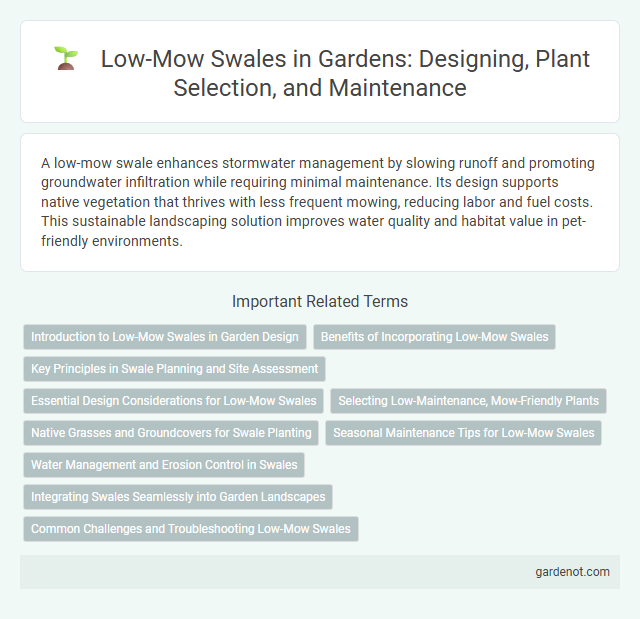A low-mow swale enhances stormwater management by slowing runoff and promoting groundwater infiltration while requiring minimal maintenance. Its design supports native vegetation that thrives with less frequent mowing, reducing labor and fuel costs. This sustainable landscaping solution improves water quality and habitat value in pet-friendly environments.
Introduction to Low-Mow Swales in Garden Design
Low-mow swales are designed to efficiently manage stormwater runoff while minimizing lawn maintenance, making them ideal for sustainable garden design. These gently sloped depressions slow water flow, promote infiltration, and reduce erosion, supporting healthy plant growth with native and drought-tolerant species. Incorporating low-mow swales enhances landscape resilience, conserves water, and creates natural habitats without the need for frequent mowing.
Benefits of Incorporating Low-Mow Swales
Low-mow swales require significantly less maintenance compared to traditional landscaped swales, reducing labor and operational costs while promoting sustainable land management. They enhance water infiltration and pollutant filtration by supporting native vegetation with deep root systems, which improve soil structure and biodiversity. Incorporating low-mow swales increases habitat value for local wildlife and contributes to climate resilience through carbon sequestration and reduced urban heat island effects.
Key Principles in Swale Planning and Site Assessment
Low-mow swales prioritize native vegetation and reduced maintenance to enhance water quality and support biodiversity. Effective swale planning involves site assessment of soil permeability, slope, and hydrology to optimize infiltration and stormwater management. Integrating key principles such as minimizing disturbance and maximizing natural filtration improves ecological benefits and long-term sustainability.
Essential Design Considerations for Low-Mow Swales
Low-mow swales require precise design elements such as appropriate soil permeability, optimal slope between 1-5%, and vegetation selection to promote efficient water infiltration and minimize maintenance. Incorporating native grasses with deep root systems enhances soil stability and supports biodiversity while reducing mowing frequency. Properly sized swales must manage peak stormwater flows to prevent erosion and ensure effective pollutant filtration within the drainage area.
Selecting Low-Maintenance, Mow-Friendly Plants
Selecting low-maintenance, mow-friendly plants for a swale involves choosing deep-rooted native grasses and drought-tolerant species to enhance soil stability and reduce watering needs. Species such as buffalo grass, blue grama, and sedges thrive with minimal mowing while supporting water infiltration and erosion control. Incorporating these resilient plants ensures a sustainable, low-labor swale that maintains functionality and aesthetics throughout the seasons.
Native Grasses and Groundcovers for Swale Planting
Low-mow swales incorporate native grasses such as little bluestem, switchgrass, and prairie dropseed, which require minimal maintenance and promote water infiltration. Native groundcovers like creeping thyme, bearberry, and wild ginger stabilize soil, reduce erosion, and enhance biodiversity in swale environments. Selecting these species supports sustainable stormwater management and fosters resilient, low-maintenance landscapes.
Seasonal Maintenance Tips for Low-Mow Swales
Seasonal maintenance of low-mow swales involves regular inspection for sediment buildup and removal of invasive weeds to ensure effective water filtration and flow. In spring, prioritize fertilization with slow-release, low-nitrogen fertilizers to promote deep root growth while minimizing runoff pollution. Fall maintenance includes cutting back dead vegetation and applying mulch to protect soil structure and encourage native plant resurgence through winter.
Water Management and Erosion Control in Swales
Low-mow swales enhance water management by promoting efficient stormwater infiltration and reducing surface runoff, thereby minimizing flood risks. These vegetated channels utilize deep-rooted, low-maintenance grasses that stabilize soil and prevent erosion along swale banks. Optimizing soil permeability within low-mow swales supports groundwater recharge while maintaining landscape aesthetics and ecological balance.
Integrating Swales Seamlessly into Garden Landscapes
Low-mow swales reduce maintenance by minimizing mowing frequency while effectively managing stormwater runoff in garden landscapes. Integrating native grasses and drought-tolerant plants within the swale promotes biodiversity and enhances natural aesthetics. Proper grading and soil amendments ensure optimal water infiltration and support a seamless blend with surrounding vegetation.
Common Challenges and Troubleshooting Low-Mow Swales
Low-mow swales often experience challenges such as sediment buildup, water pooling, and invasive vegetation, which can reduce their effectiveness in stormwater management. Effective troubleshooting involves regular inspection for blockages, maintaining appropriate grass height to balance mowing frequency and vegetation health, and implementing erosion control measures to preserve swale integrity. Addressing these issues promptly ensures optimal water infiltration and pollutant filtration, enhancing swale performance in urban landscapes.
Low-mow swale Infographic

 gardenot.com
gardenot.com